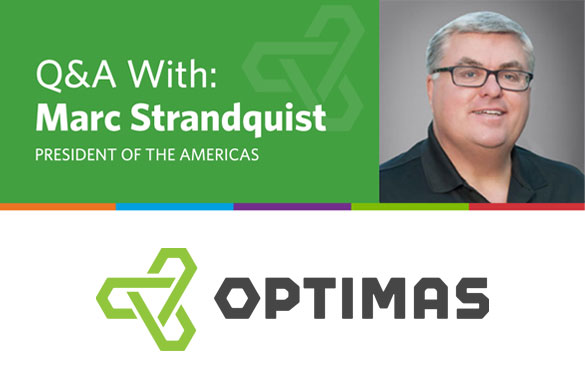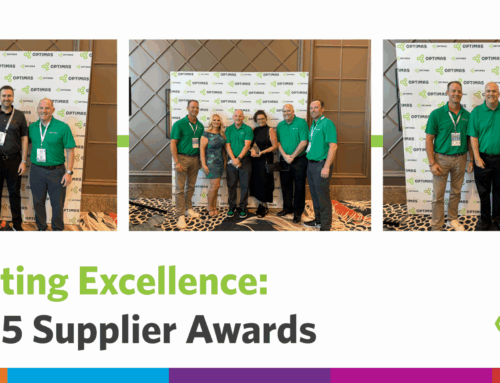
COVID-19 およびそれ以降のサプライ チェーンの保護
2020 年の中間点を過ぎた今、Optimas の南北アメリカ担当プレジデントである Marc Strandquist に、現在のサプライ チェーンの状態、これまでに学んだこと、および今後のサプライ チェーンを保護する方法について尋ねました。
現在、製造業者にとって最大の課題は何ですか?
手短に言えば、真の需要を理解することです。 1 月には、顧客が 1 日 200 ユニットを建設し、その後 4 月に閉鎖するのを見ました。製造業者が再開し、生産を増やし始めたとき、彼らはおそらく 1 日 50 台から始めました。これは 6 か月前よりも大幅に減少しており、多くの人が最善の数字を推測していました。特にこのような不安定な市場では、生産を予測して調整することは困難です。
メーカーのさらに上流には、材料サプライヤーがあります。たとえば、鉄鋼業界は、下流での生産の停滞と縮小によって引き起こされる在庫の増加と価格の下落を回避するために、生産を調整しなければなりませんでした。
私たちは皆、ウイルスが全国的に2度目に急増した場合、物事が異なる方法で処理され、すべてをシャットダウンしてこのサイクルを最初からやり直すのではなく、経済を保護するためのより良い方法を見つけることを望み、祈っています.
製造業者が苦労している他の課題にはどのようなものがありますか?
多くのサプライヤーが不可抗力を宣言したり廃業したりして、流通業者や製造業者を立ち往生させ、サプライチェーンに大きな混乱を引き起こしています。
産業界も移動制限や移動制限に対処しなければなりませんでした。彼らは顧客を訪問したり、重要な取引先と会うことができず、顧客との関係を悪化させています。
そしてもちろん、キャッシュフローに苦しんでいる企業もあります。
一部の企業は、他の企業よりもこの危機に対処する準備ができていました。それらの企業は何を正しく行いましたか?
顧客やサプライヤーとのコミュニケーションに非常に積極的な姿勢をとっていたと思います。彼らは、快適さを提供する絶え間ない更新とチェックインを提供するようにしました。
また、テクノロジーを活用し、サプライ チェーンを可能な限りデジタル化した企業は、適切なデータを取得して、在庫を押し出す延期やキャンセルの需要計画を改善し、手元に十分な現金を確保できました。
不意を突かれた人はどうですか?
コミュニケーションはとても重要です。顧客やサプライヤー パートナーと事前に効果的にコミュニケーションをとっていなかった企業は、最も苦労しました。彼らは適切に反応することも、十分に速く反応することもできませんでした。私たちが最近目撃したように、シャットダウンは私たちを無防備で無防備な状態にします。明確で透過的なコミュニケーションにより、リスクをより軽減できます。
そして、2020 年のパンデミックに関してこれまで見てきたことから、主に低コスト、単一のソース、および少ない在庫に基づいて構築されたサプライ チェーンは、このような大規模な混乱に対処するための設備が最も整っていませんでした。
最後に、適切なサプライヤーやサプライ チェーン パートナーとの強力な関係を持たないことは、多くのビジネスに損害を与えると思います。
コースを修正して安定させるためにメーカーが行っていることは何ですか?
適切なリスク軽減戦略、多様な調達、デジタル化、およびサプライヤーとの強力な関係を備えた企業は、より回復力がありました。
サプライ チェーンの多様化を開始し、オンショア サプライ チェーン戦略を実施して国内製造に投資した企業は、リスクを大幅に低減しています。
良いニュースは、米国の製造業がこれによって大きな恩恵を受けることです。
たとえば、Optimas では、シカゴ地域の施設で大量かつ高品質の製造を行っています。国内調達と海外調達への関心が高まっています。
第 4 四半期に向けて引き続きどのようなサプライ チェーンの課題が見られるでしょうか?
企業とそのリーダーにとっての課題は、彼らの手に負えないものになるでしょう。これは、州または国レベルでの政府機関の閉鎖が増えることを意味します。在庫を計画し、需要を予測し、それに応じて労働力を調整することは不可能になります。
サプライチェーンを安定させ、リスクを最小限に抑えるために、製造業者は今何ができるでしょうか?
消費するものに関する正確なデータを取得します。それが#1です。産業用ディストリビューターとして、お客様の在庫を確保するのに問題はありませんが、可能な限り最高レベルのサービスを保証するには、適切なデータが必要です。視認性を高めることが重要です。
サプライチェーンを確保し続けるには、どのような長期的な解決策が必要ですか?
すべての企業は、自社の供給基盤と商品戦略を徹底的に見直す必要があります。安定していて、財政的に実行可能で、提供できる能力があるサプライヤーと契約を結ぶようにしてください。先ほどの話に戻りますが、透明性のあるコミュニケーションと人間関係が重要です。
COVID-19 によってサプライ チェーンはどのように永久に変化するのでしょうか?
まったく新しいビジネスのやり方が生まれることは間違いありません。人との接触が減り、Zoom/Teams ミーティングが増え、移動も制限される可能性が高くなります。これらのことは、長い間私たちと共にあります。しかし、これは私たち全員にとって、ビジネス目標の達成を支援するために、顧客とのやり取りや連絡方法を工夫する機会です。
また、国産化への関心は今後も続くと思います。製造業者は、総所有コストを削減するだけでなく、自社の生産と顧客に対してより良いサポートを受けることを目指しています。
COVID-19 から脱却したときのリバウンドはどのようなものになるでしょうか?
この時間をかけて社内でビジネスに集中し、従業員を訓練し、会社を強化した企業は、市場に出て市場シェアを獲得できるでしょう。受動的で時間を無駄にした人は、大小を問わず取り残されます。市場に浸透するために、多くの積極的な行動が行われるでしょう。
Optimas では、この 5 か月間かなり忙しくしていました。技術のアップグレード、新しい市場への拡大、および顧客向けの新しい製品の品揃えへの投資に投資してきたため、市場シェアを獲得して成長するための準備が整っています。
この間、リーダーとして学んだことを 1 つ挙げてください。
在宅勤務についての考え方を変えなければなりませんでした。私はウイルスの前はこのコンセプトのファンではありませんでした。ビジネスの質を落とすか、難しすぎると思いました。欠点は、全員が離れていると、チームの友情が少し失われ、企業文化が損なわれることです。結局、シームレスな移行になりました。従業員が仕事を続けられるように、必要なものにアクセスできるようにしました。
次の事態に備えるにはどうすればよいでしょうか。
顧客が今すぐに売り込まれたくないことをチームが理解していることを確認してください。顧客は答えを求めており、次に何をすべきかを理解する手助けをしてくれます。顧客のニーズに迅速に対応し、従業員が適切に指導され、現在の状況で働くように訓練されていることを確認してください。チャンスはいくらでもありますが、適切に準備し、柔軟に対応する必要があります。
2 Comments
コメントを残す
コメントを投稿するには、ログインする必要があります。







[…] COVID-19 は、私たちの公衆衛生、経済、企業の財務に大きな打撃を与えました。多くのことが危機にさらされている今、私たち全員の良し悪しは、今まさに私たちの隣に立っているパートナー次第です。適切な産業サプライチェーン パートナーシップを見つけることが、パンデミックを乗り越え、その後も生き残るための鍵となります。 […]
[…] 現在、メーカーはこれまで以上にサプライ チェーンに気を配っています。その意識から、効率性と回復力を向上させる方法について多くの疑問が生じています。私は 30 年近く流通およびサプライ チェーンの専門家として働いてきたため、供給の継続性と顧客の需要のバランスを取ることの難しさを理解しています。COVID-19 により、最も安全なサプライ チェーンでも脆弱性が露呈したため、サプライ チェーン マネージャーは複雑さが増す中で対応しています。複雑な領域を簡素化し、弱いリンクを安定させる方法を知っていれば、需要の変化に応じて迅速に規模を拡大または縮小できます。以下は、より強力で回復力のあるサプライ チェーンを実現するために部品管理を合理化するための、常に役立つヒントです。 […]